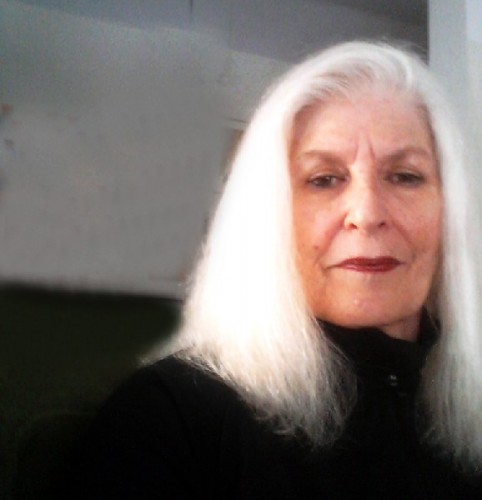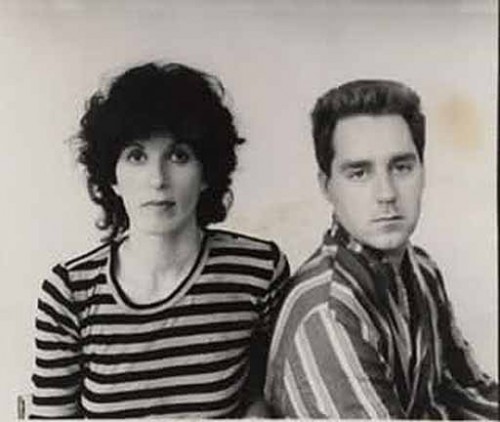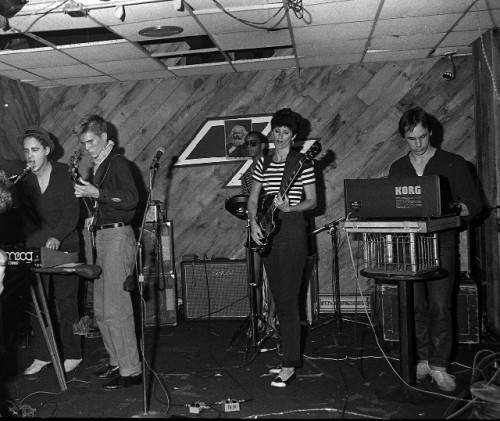Jane Hudson of Williamstown’s New CD
Links and Bridges on Cutting Edge
By: Charles Giuliano - Aug 10, 2013
Jane Hudson who partners with her husband Jeff in operating the landmark Hudsons Antiques at the entrance of Mass MoCA also has a complex creative life that they share. Starting with the Boston based punk band The Rentals decades ago they have moved with technologies and trends in creating new music.
As Jeff and Jane they have performed with digital equipment and vocals at Mass MoCA and the Williams Inn. Some of their earlier work has been re-released creating an esoteric international fan base.
Taking advantage of new computer programming Jane has released her first solo album Jane Hudson Links and Bridges. Having covered their exhibitions and performances over the years we engaged in a dialogue about this latest project.
Charles Giuliano Driving around in my car, echoing the lyrics of one of your songs, I have been listening to your solo CD. How did this project come about and over what time frame? What was the artistic motivation for creating and recording this new compilation of material?
Jane Hudson Glad to hear you're checking out Links and Bridges! Bringing it back to the beginning, I started working on new material after Jeff and Jane performed to support the re-release of our original synth tracks on FLESH by Captured Tracks (Brooklyn/Dark Enries Records (San Francisco). In the summer of 2012 Jeff was working on his own solo EDM (Electronic Dance Music) and ultimately released his CD, Boingy! I decided to leap into the fray to learn GarageBand software (for my IPad) so I could write while working in the shop (HUDSONS) at Mass MoCA. So that's the beginning!
Most of my life I've been writing poetry and in certain instances these have been adapted for songs. So I've had things to say! Also, I was trained as a kid in classical solfeggio, or music theory and did play the piano for some years. My father, Leonard Shure, was a highly accomplished pianist, so faced with that daunting presence, I did not pursue a career in the classics. Instead, jazz and rock were my loves. And I had lots of fun being a rocker. So this was my chance to explore my own musicality, and create a body of songs that unfurls that sensibility. To tell you the truth, it's kind of surprising to me, but in keeping with what I know and want to discover. FYI, the title comes from reading Giles Deleuze, the brilliant postmodern French philosopher, who explores the viral connections, unexpected trajectories and other valences of experience.
How's that?
CG Oar was a 1969 solo album by Moby Grape co-founder Skip Spence. It was his only solo album, recorded over seven days in Nashville, on which he played all of the instruments. In 1970 Paul McCartney released McCartney. Apart from then-wife Linda's vocal contributions, he performed the entire album solo. Featuring loosely arranged (and in some cases, unfinished) home recording.
Some 40 plus years ago those solo albums were regarded as phenomenal. Now that is not so unusual. Of course much of the difference is that Spence and McCartney were performing with conventional instruments and laying down tracks with overdubbing.
When I have heard Jeff and Jane perform recently it appeared that Jeff played keyboards and, with programming, was able to simulate multiple instruments as well as percussion. You, as I recall, played conventional electric bass.
Walk me through what I am hearing on the current CD. Are you creating all of the music from singing to “instruments?”
How has making music changed in the decades since those pioneering rock solo albums and what is being done in the studio today?
There seems to be loss and gain. On the one hand a great expansion of technical possibilities for the artist and on the other the loss of a human element and personality of playing conventional instruments.
Of course there is a matter of economics. It’s expensive to hire musicians for studio recordings. This makes it possible to record with cost effective simplicity. Factor into that the time and sweat equity of learning the programming.
Here the human element is the voice. But even that, at some point, might be programmable where in a digital mix it will be possible to alter and simulate the voice.
Where do we locate you on this developmental and aesthetic trajectory?
JH Ok, first let me clarify J&J's instrumentation. Much of what you heard was prerecorded. We both played synths. I happened to play more melodies and Jeff more ambient sounds and percussion.
On the CD, with the exception of “In My Car” and “The Stand” where Jeff has done percussion, effects and production, I have written musical lines from my Yamaha keyboard into GarageBand and have performed vocals as well. It is really amazing how much musical Information can be generated virtually. There is a variety of synths as well as virtual guitars, horns, drums, etc. GarageBand only allows 8 tracks, so one has to be economical with the structure of a song.
Obviously, our early recording emphasized more actual instrumentation, but even back in the day, we were playing synths, drum machines, etc. The punk band, The Rentals, our first, was all electric real instruments, and I played bass. Jeff on guitar and PseudoCarol on drums. Of course, there's the aspect of performance which demands some actual playing. I'm not sure I'll perform this album. It's lots of work, of course, I love an audience!
Recording used to be a pretty sophisticated and professional business, you went into the studio and an engineer and producer watched over the performances keenly. Expensive and time-consuming, Now, with the right software, Reason, Cubase, ProTools, it's possible to do it all virtually!
I will not get into the argument about the loss of the 'human' factor with modern technology. We created it, we use it, it reflects our sensibilities as much as any acoustic instrument, of course there is a huge roots music revival now of folks refusing the tech approach. The beat goes on.
As to my own trajectory, gosh, I hope I have one for a while! Being older doesn't preclude having dreams. Same time I'm realistic about my chances to be popular. It's wonderful that a new generation of artists are speaking to their peers like Ellie Goulding and Macklemore and Ryan. I can't hope to do that. But for a select few, I may have some relevance yet.
CG The new CD Jane Hudson Links and Bridges does not include liner notes. The top of the jewel box is clear and we see through to the disc so there is no sleeve insert. This leaves us on our own to contemplate the intentionality of the material. You have stated that “FYI, the title comes from reading Giles Deleuze, the brilliant postmodern French philosopher, who explores the viral connections, unexpected trajectories and other valences of experience.”
That will be lost on anyone listening to the music and begs for more clarification. What is the connection between the songs? Are they a compilation of recent compositions or is there an intended confluence and thematic development?
The tracks include: “Make It So” “The Other” “Total Abandon” “The Place” “In My Car” “Innocent” “Time” “The Stand” “Small Town” ‘Mixed Emotions” and “Trip to Mars.”
Can you give us liner notes and a listener’s guide to the project? What is this about? You are taking us to a place but where are we going?
For me the seminal work in your oeuvre was “Gertrude Stein, Gertrude Stein.” It seemed to establish a number of signifiers for your aesthetic. First the obvious connection to an iconic woman poet and lesbian as artist, poet and uber feminist.
On another level there was a connection to poetry an emulation of her unique, deadpan delivery and repeated lines. While a student at Harvard Summer School, bored with studying chemistry, I spent a lot of time in the Lamont Library listing to recordings of Stein, Eliot, Dylan Thomas and other poets. So I am familiar with her unique cadence which for me informs your style.
In the rock sphere one might add Leonard Cohen as a link to your approach. The vocals occupy a mid point between sung and spoken. Not rap so I prefer the term incantation. Listening to the CD there is a dirge like delivery that threads through the work with an emphasis on the importance of the word enhanced by the elements of rhythm and ersatz instrumentation as you have described the use of synths and their range of sounds.
JH There are no liner notes because the price grows exponentially when lots of graphics are included in the production costs. Same time, I can go through the songs and try to speak to intentionality.
I think the title comes not so much from a thematic approach, actually its opposite. These relationships may be literary, or sonic, but aside from the fact of the songs having been written and performed by me, they have distinctive qualities. So the listener can weave pieces in many ways to develop meaningful patterns.
'Make It So' refers to the collective experience of place, its history and the way science and religion form it and develop it and try to control it. But the way things are emerges from the ground up and is always finding fertile ground to grow in.
'The Other' is about people who are made invisible but who are essential to our way of life.
'Total Abandon' is quite personal and deals with a movement from ecstatic emergence of youth through some doubt in the middle years, and now the encounter with the real, that ultimate knowledge.
'The Place' is about sacred spaces in nature where balance can be experienced as dynamic and regenerative.
'In My Car' is about driving and urbanity. The joy of movement and connectivity special to the car. (This piece was released on a 12 vinyl in 2012 by Electric Voice Records, Halifax, Nova Scotia. It is co-written by Jeff Hudson)
'Innocent' is a mystery, a drama, and a metaphor for all the small crimes we commit.
'Time' brings us back to Deleuze who identifies the web of space-time-experience. Of course, our experinece is linear to our perception and (re)forms us over the course of our lives. But what happens is all quantum nonsense!
'The Stand' is about all the uprisings in the world from the Arab Spring to Occupy Wallstreet, and how revolutions begin. (Co-written with Jeff Hudson. Released on Electric Voice Records Compilation LP, 2013)
'Small Town' is kind of a template for the ideal town, at the same time it refers to the ingredients for social interaction and culture at its base. Almost tongue in cheek.
'Mixed Emotions' is something we all feel, especially in relationships. There's expectation and there's human fallibility. Limitations.
'Trip to Mars' is just a little musical interlude, no agenda.
I guess this CD is about my observations and reservations at this point in life.
Speaking to the 'dirge' comment, I can identify with Leonard Cohen and Marianne Faithful. I like to sing!
As to style of writing, yes Stein, but also Eliot and Cummings and Ginsberg and Plath. The Cure, Depeche Mode, The Killers, Muse, Daft Punk, and Chet Baker too! Yes, a kind of brute, spare, minimal take.
As to machines, GarageBand, the program I used, is quite limited in terms of the range of sounds one can find. I tend to like a slinky piano, maybe an airy synth and a syncopated rhythm. But I've started working with Reason and should have a much greater choice for the next batch of tunes.
I do have one other credit for a piece called 'Authority' (my poem and reading) produced by the French group HNN with Gregg Anthe.
CG You talk about the cost of graphics and other production aspects. Can you shed some light on how you self publish a CD like this? Is it like a Blurb book where you pay by the unit and use template to create it?
Do you pay for an edition? Like a press run of so many units? Perhaps a hundred or some other doable number? Or can the CDs be pressed (if that is the term left over from vinyl) as the orders come in?
Which cuts to the issue of marketing. How does one get the word out? Today there seems to be little chance of getting air time other than college stations or perhaps on line. I really don’t know anything about the world of alt and indy music so perhaps you can help us here.
Of course many performers promote and sell their product during performances. It is a way of reaching and expanding the fan base as well as marketing the product.
In the former days bands went out in support of a new release. The companies subsidized the marketing. Often the band made their money through signing with a label. Then got royalties, a tricky business, as units were sold.
With the CD market largely tanked it appears that bands make their money by performing and touring. Young consumers have the notion that art, like recorded music, should be free.
Again, as an outsider, one senses that the business and marketing model has entirely changed.
One assumes that you create this CD because you have a fan base for the music. So how do you define that goal? Who are the potential listeners that you are trying to reach? What are the usual strategies now with so many individuals, particularly with the programs you have described, capable of recording, pressing and releasing product?
We used to describe self publishing as vanity press. But now it is so ubiquitous, and the traditional publishing houses and record companies are so weakened and changed, that there are new paradigms.
An increment of self published material goes viral and there are stories of individuals making a lot of money and reaching large audiences. Is there an equivalent of Amazon for books as a vehicle to promote and sell CDs?
You talk about a next project. What is the impetus to work on new material? One assumes that this release has to achieve goals as an incentive for the next one.
This is an interesting phenomenon that is bringing many more voices and visions into the mix.
In the film/ video, music world, for example, there is speculation about a “film” shot or recorded on an I Phone for $1,000 that will one day win an Oscar or Grammy.
What has always impressed me about your practice is how you and Jeff (Hudson) were always embracing the possibilities of new technologies and aesthetic developments. I remember seeing some of my first examples of video/ conceptual art in your loft on Atlantic Avenue decades ago. Compared to today the video equipment was expensive, cumbersome and primitive with reel to reel tape.
You were early as artists to expand from visual art to punk music. That also cut back as Jeff went on to work with lots of bands to create their videos. It was the era of the emergence of MTV.
Fast forward to today and the creative world you were experimenting with has progressed with warp speed. It intrigues me that you continue to surf the cutting edge.
JH The miracle of the digital world is the ubiquity of file formats and the interchangeability within digital media. So making the music, mixing and mastering the tracks, creating the graphics and promoting the album all fall within the same computer arena. It is THE matrix medium! In my case, the files were sent to a mastering company that pressed a run of two hundred including graphics and jewel box. Now it's my job to promote the album through email, snail mail and social media. Because of the recent release of J &J's FLESH album, college DJ 's might be more likely to listen. I do not expect to perform which does limit the spread of my songs. At the same time, I may do some kind of track date locally.
I could reach out to iTunes and post the album there, but that's a step down the road after I see if there's any interest.
It is possible now for anyone with access to computers to produce some kind of musical material. Much of what's being done now happens that way. Even the CD itself is a dying format! New cars don't have the players, and new computers don't either. So the material goes totally digital even existing solely on the Cloud!
Of course, there's a roots movement that directly challenges the digital with performers going back to "old timey' instrumentation and 'folk' forms. There does always seem to be this dichotomy, and reaction back and forth.
Moving with the technology has been our practice. We divest of old gear for new gear about every three or four years give or take. The possibility of moving onto platforms that streamline our practice, or invite new forms due to advances in interactivity, is always enticing. It's also a way of staying abreast of the current cultural discourses impacted by technology.







